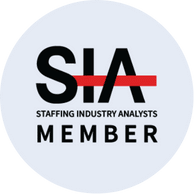In recent years, healthcare organizations have learned the vital importance of both recruitment and retention strategies. Whether it’s finding effective candidates or reducing burnout in current staff, healthcare organizations are always looking for useful strategies to improve their staffing efforts.
As you attempt to address your facility’s staffing needs, you’ll want to know these five effective steps you should follow to build an effective recruitment and retention strategy for medical staff.
1. Begin By Understanding Your Current Medical Staffing Needs
The foundation for any effective healthcare recruitment and retention strategy is understanding your current medical staffing needs. The most important areas you’ll need to focus on include:
- Evaluating your current culture and ensuring any new hires fit your organization’s values and culture.
- Identifying your current staffing needs, including your required skill sets and specialties, such as emergency medicine, locum hospitalists, locum intensivists, and nurses.
- Determining whether you need locums and moonlighting staff, and if so, the length of time and number of monthly shifts you’ll need locum tenens staff members to fill.
Once you’ve gone through the list above, you’ll want to tailor your ads, job postings, and other recruitment methods to your specific hiring needs. While some think they should cast a wide net and post vague job postings, more specific job listings will cut down on unqualified applicants and attract more qualified ones. Top candidates typically want certainty and to work for an organized medical provider, so being specific in your recruitment efforts can attract these types of candidates.
2. Revamp Your Recruitment Strategy
Once you’ve identified your primary medical staffing needs, you’ll want to upgrade your recruitment methods and diversify your recruitment channels. Some of the top recruitment channels that can increase applicants include:
- Advertising specific job openings at physician networking conferences and events
- Utilizing targeted advertising and social media platforms
- Recruiting via specific ads on online job boards and the sites of medical associations
- Partnering with medical facility staffing agencies
Alongside using multiple recruitment channels, you’ll want to focus on ensuring your application and interview process is streamlined. For example, healthcare organizations should have an easy-to-use online application system. Your team should also develop efficient and prompt protocols for communicating with candidates. Additionally, the interview and evaluation processes should be adjusted for simplicity and speed. By streamlining these components of the application and interview process, candidates will be more likely to complete the application and have a more positive view of your organization.
3. Improve Your Pay and Benefits Packages
Another way you can improve recruitment and retention is to overhaul your pay and benefits. In a competitive hiring environment, companies with higher pay and more comprehensive benefit packages will often win out over other healthcare organizations. Including signing bonuses in new-hire packages can also be an effective way to attract top talent.
Improved pay and benefits packages can also reduce the risk of higher-paying organizations poaching current staff. While you’ll need to pay current staff more, it may save you money as retention cuts down on expenses related to new hire training and onboarding. You can also increase retention by offering chances to staff to take time off to attend medical conferences or complete specialized training to grow their skills. Additionally, you can show you value your current employees by offering clear pathways to promotion.
4. Provide Flexibility to Current Staff When Possible
Due to the pandemic, many physicians and other medical staff began to move to telehealth for at least a portion of their appointments. Though many appointments must take place in person, allowing your team to schedule remote work when possible can be a great way to improve employee retention. Since telehealth appointments promote flexibility, medical professionals who want a better work-life balance often prefer organizations that offer them.
Since remote work isn’t possible in many positions, you can discuss with your staff any ideas for scheduling that would assist with their work-life balance. A great healthcare organization will offer creative scheduling opportunities for staff who want greater flexibility. Typically, it’s best to discuss scheduling ideas with current employees and use their ideas to provide more scheduling flexibility to them.
5. Use Locums Tenens and Moonlighting Staff to Minimize Burnout
Staffing shortages often mean a healthcare organization’s current staff have to work longer hours to provide care to patients. While staff can handle longer shifts for short periods, they’ll eventually become burnt out, resulting in productivity losses and quitting. Fortunately, locum tenens and moonlighting staff from a medical facility staffing partner can reduce the workload on your team.
With locum tenens staff from a medical staffing partner, you can more easily fill temporary positions. Since a staffing partner will have a wide network of qualified staff and close relationships with your team, they can quickly find excellent candidates when you’re facing a staffing shortage or current staff are on leave. As a result, you can offer more PTO and other wellness opportunities to your current staff, minimizing employee burnout and improving retention in the process.
Choose OnCall Solutions for Facility Staffing Solutions
At OnCall Solutions, we’re ready to streamline the hiring process for you. As a medical staffing partner, we regularly help healthcare organizations receive locum tenens and permanent staff. Whether you need temporary CRNAs or permanent physicians, our dedicated recruiters will work with you closely to find qualified candidates who fit your culture. Alongside helping with recruitment, our team can lighten your HR team’s workload by assisting with onboarding, billing, and credentialing processes.
Learn more about our facility staffing solutions today. If you’re ready to get started or have any questions, please contact us.




